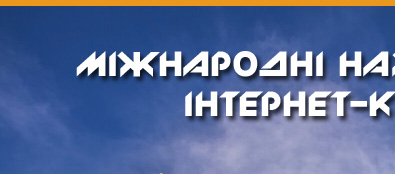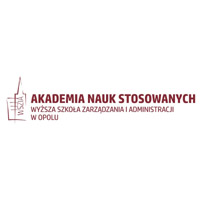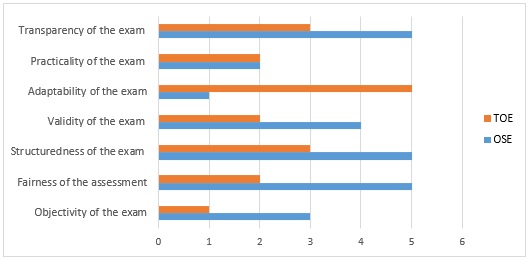Exams in clinical disciplines in medical school are an important step for a student to achieve their goal of becoming a doctor. The profession of a doctor is chosen by those who have a high motivation to help people [1, p. 473]. It is known that a doctor should be responsible and disciplined, sensitive and resolute, calm and confident [2, p. 7]. The high social and public significance of the doctor's profession requires a high level of professional training, fundamental knowledge of theoretical and experimental medicine, communication skills and clinical examination of the patient, effective application of modern standards of diagnosis, treatment and prevention of diseases [3, p. 1]. It should be noted that successful passing exams in clinical disciplines helps a graduate not only to navigate the choice of a future medical specialty, but also to pass the most important test upon graduation from a medical university confidently – the Unified State Qualification Exam (USQE).
In Ukraine the main form of certification of students in the field of knowledge “Healthcare” is USQE, which is carried out in two stages: the first stage is the integrated test exam “STEP-2”, the second stage is the Objective Structured Clinical Examination (OSCE).
The approved format of USQE is designed to ensure a high level of training of Ukrainian medical professionals, unification of their education standards, and integration into the international educational and scientific space. The overall results of USQE are key indicators not only of the professional suitability of students for higher medical education, but also a kind of reflection of the quality of the educational process in the university throughout the entire period of study. Undoubtedly, the results of the exams directly depend on the perseverance, concentration and discipline of the student, but the high professional competence of teachers and the organization of the preparatory process for taking USQE in the university is also of a great influence [4, p.
Thus, starting from 2024-2025 academic year Odesa National Medical University (ONMedU) has introduced an Oral Structured Exam (OSE) at clinical departments instead of the Traditional Oral Exam (TOE), which is intended to more effectively prepare graduates for USQE.
According to the approved curricula, 60 theoretical questions and 30 typical situational tasks are assigned to the clinical discipline exam. It is important to emphasize that ONMedU has a separate structural unit - the "Educational and Production Complex of Innovative Technologies of Training, Informatization, and Continuing Education" (EPC ITTICE), which has the necessary level of personnel and material and technical support. One of the tasks of EPC ITTICE is to conduct the clinical discipline exam, both online and offline. The exam is conducted using the Microsoft Teams platform under constant video and audio monitoring. The exam paper, which is automatically generated by a computer program, consists of three tasks - two theoretical questions and one situational task. Theoretical questions for the clinical discipline exam are concisely and competently formulated using modern and professional terminology. Situational tasks have a limited amount of text with a mandatory practice-oriented content direction. Each situational task has five tasks, which necessarily involve determining the leading clinical symptom/syndrome or preliminary diagnosis, drawing up a plan for clinical examination and treatment at different stages of medical care, interpreting the results of clinical and laboratory and instrumental examination methods, conducting differential diagnostics. Also, an important requirement for examination card for OSE is the specificity and accuracy of wording in the tasks, so that the full answer to each of them takes no more than 5 minutes, therefore the duration of the exam is no more than 15 minutes. The student's answer to each task is assessed only using a checklist.
During the exam (OSE), only the examiner and the student are in the exam room, each sitting in front of his/her computer monitor. At the beginning of the exam, the student sees only the current theoretical task or the full text of the situational task on the computer monitor, and the teacher sees the corresponding checklist. The student is prohibited from using any gadgets, educational materials, notes, etc. The teacher is prohibited from explaining the material, asking clarifying questions, or giving additional tasks. The teacher is also prohibited from using verbal and non-verbal means of communication that would direct the student to the correct answer or confuse him/her.
The overall score for OSE is calculated as the arithmetic mean of all the marks received for the answers.
Therefore, the purpose of our study was to compare OSE and TOE with each other, with the determination of a more effective method of assessing the level of the student preparation. We analyzed seven basic parameters of the exams on a 5-point scale (5 points - very high, 4 points - high, 3 points - moderate, 2 points - low, 1 point - very low).
The first parameter that we considered is the objectivity of OSE and TOE. It should be noted that according to the requirements, a high level of objectivity is possible with an exam format that involves all students performing the same tasks with the evaluation of answers using a checklist. On OSE and TOE in clinical disciplines, different theoretical questions are asked in terms of complexity and themes, but it is OSE that provides for the use of a checklist. This significant difference excludes the possibility of subjectivity of assessment by the examiner. Taking into account these positions, the objectivity of TOE is very low, and that of OSE is moderate (graph 1).
The next criterion is closely related to the previous one – it is the fairness of the assessment. On OSE, the use of computer programs and video surveillance when filling out the checklist makes it impossible for the examiner to influence the test, so this indicator becomes very high.
The structure of the exam. On OSE, the structure of the exam card is formed by a computer program and all students have the same time (5 minutes) for answers. On TOE, students take cards and the time given for the preparation is not always fixed.
The next parameter analyzed is the validity or reliability of the exam. This is a general term that usually reflects the relationship between the exam score and the student's level of assimilation of the educational material. The format of OSE allows for a high correlation.
Graph 1
Comparison of the oral structured exam (OSE) and the traditional oral exam (TOE) in clinical disciplines
The adaptability of the exam is the ability of the examiner to ask the student leading questions if necessary. OSE has a very low adaptability, on the contrary, the format of TOE determines a very high indicator.
Practicality of the exam. This is an extremely important criterion for the exam in clinical disciplines. The use of the results of clinical and lab oratory tests, instrumental examination methods, photo and video materials during OSE and TOE is a significant factor in creating realistic clinical and diagnostic and treatment situations, however, these exam formats do not provide an opportunity to assess the degree of students' mastery of communicative and practical skills, and therefore the competence to apply existing knowledge in practice.
Transparency of the exam. Unlike TOE, OSE is conducted with the mandatory use of the Microsoft Teams platform, which provides for video recording of the entire exam process that allows students to appeal the exam result. In TOE transparency is moderate and the process of appealing the results is more complex and emotionally stressful, due to the high risk of conflicting judgments.
Thus, the format of OSE has significant advantages over TOE, namely high fairness of assessment, validity, structure and transparency of the exam, as well as its moderate objectivity. Among the shortcomings of OSE we noted low practicality and very low adaptability. In our opinion, the implementation of the updated version of the exam for clinical disciplines at ONMedU is a successful example of professionalism, creativity and responsibility of the university management and teaching staff in the sole goal of continuous improvement of educational services, which is a priority task of Ukrainian medical universities.
References:
1. Tal O, Bitan M. Professionalism and Self-Evaluation: Diverging Perspectives Among Physicians and Nurses. J Healthc Leadersh. 2024;16:473-483. Published 2024 Nov 6. doi:10.2147/JHL.S483515
2. Briedé S, de Winter MA, van Charldorp TC, Kaasjager KAH. The effect of physician training and patient education on the discussion of care decisions at the internal medicine outpatient clinic. BMC Health Serv Res. 2022;22(1):1569. Published 2022 Dec 22. doi:10.1186/s12913-022-08901-7
3. Doukas DJ. Promoting professionalism through humanities-based transformation. Ann Med. 2024;56(1):2386039. doi:10.1080/07853890.2024.2386039
4. Hayat AA, Shateri K, Amini M, Shokrpour N. Relationships between academic self-efficacy, learning-related emotions, and metacognitive learning strategies with academic performance in medical students: a structural equation model. BMC Med Educ. 2020;20(1):76. Published 2020 Mar 17. doi:10.1186/s12909-020-01995-9
|








